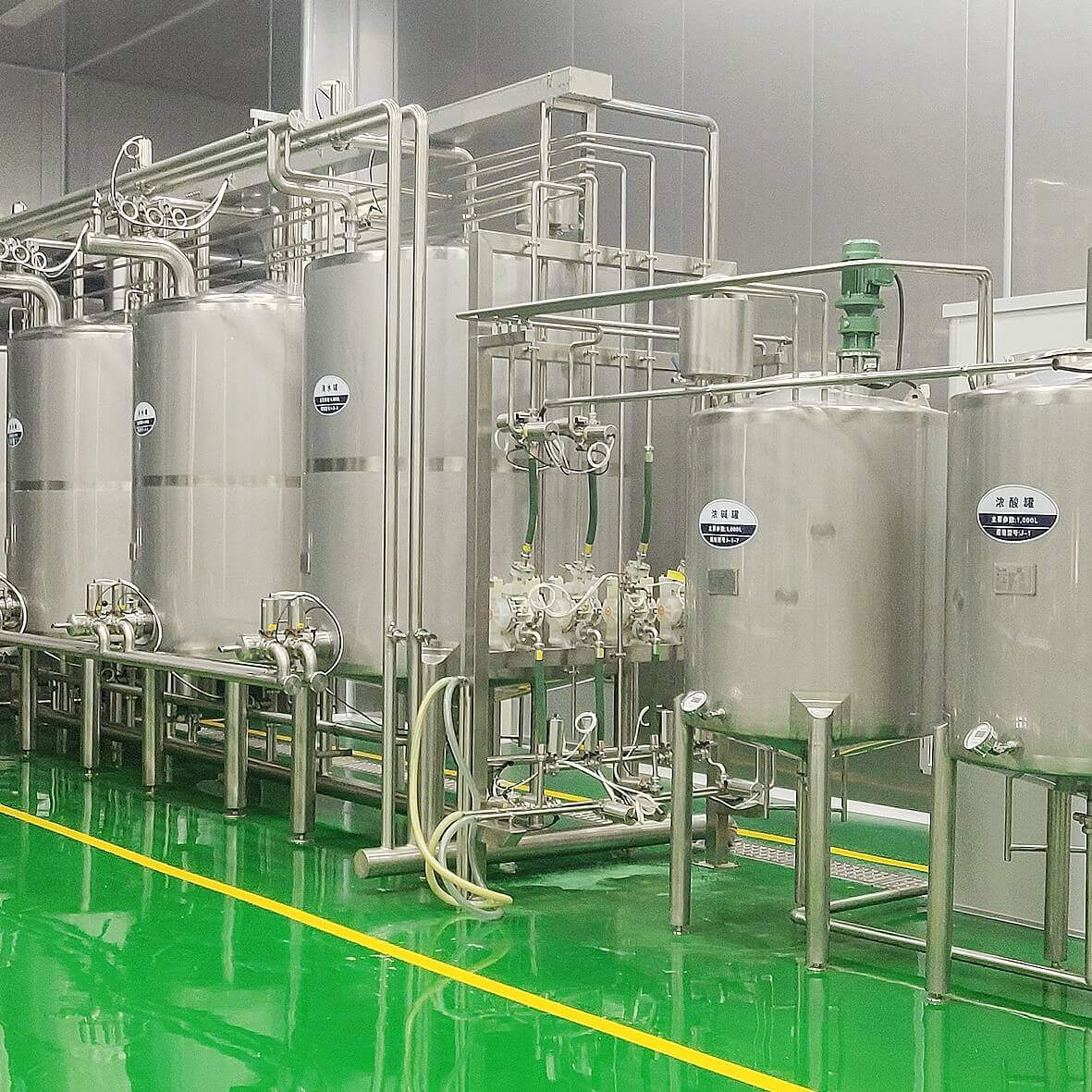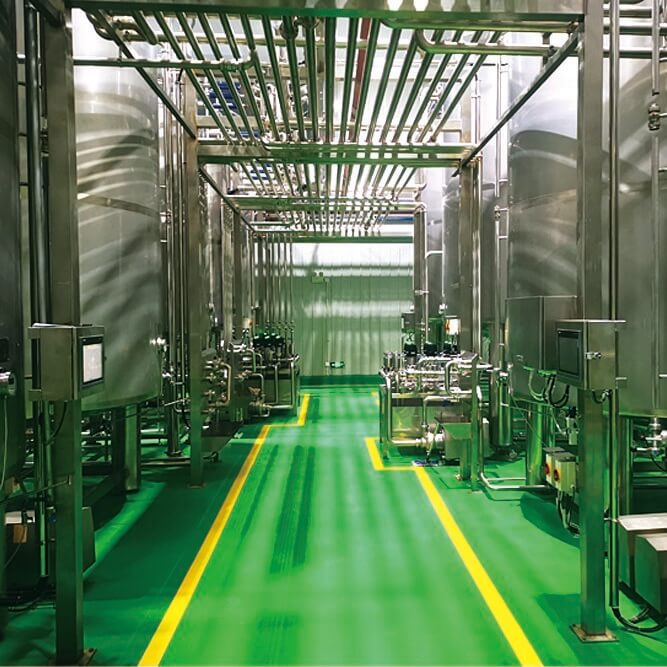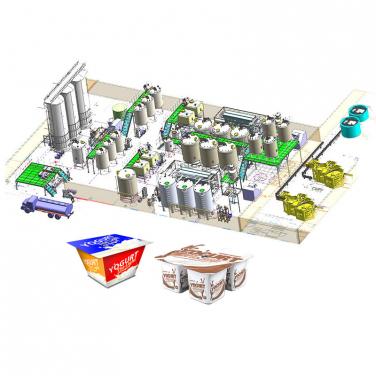
The main characteristics and working principles of the CIP system include:
2. Automatic control: CIP systems usually use PLC (programmable logic controller) or other control systems to accurately control the cleaning process, including the ratio of cleaning solution, temperature, cycle time, flushing process and other steps.
3. Multi stage cleaning: The cleaning process is generally divided into multiple stages such as pre washing, alkali washing, acid washing, and final washing, and may include disinfection or passivation to ensure that all surfaces in contact with the product are thoroughly cleaned.
4. Cleaning media: According to the needs of different cleaning stages, different cleaning agents are used, such as water, alkaline cleaning agents to remove fat and protein dirt, acidic cleaning agents to remove mineral deposits, and sometimes disinfectants are used for sterilization treatment.
5. Component composition: A complete CIP system includes cleaning solution storage tanks (such as acid tanks, alkali tanks, water tanks), heating and cooling devices, pumping systems, cleaning nozzles, valves, pipelines, sensors (such as pH meters, conductivity meters, thermometers, etc.), and control systems.
6. Energy saving and efficiency: Compared to manual cleaning, the CIP system can provide a more consistent and efficient cleaning effect, while reducing the consumption of water resources and chemical cleaning agents, and reducing labor intensity and the risk of cross contamination.
Through such an automation system, enterprises can ensure that their production lines meet strict quality standards and food safety regulations during the continuous production process.
The CIP system refers to the Cleaning in Place system, which is an automated system used for cleaning and disinfecting industrial equipment. The CIP system is widely used in production processes in industries such as food, pharmaceuticals, and chemicals, and can effectively clean and disinfect various equipment to ensure product quality and production efficiency.

The CIP system typically consists of the following components:
1. Cleaning agent supply system: Provides storage and supply devices for cleaning agents (such as alkaline solutions, acidic solutions, bleaches, etc.).
2. Circulating system: The cleaning agent is transported from the supply system to the equipment that needs to be cleaned by a pump, and the cleaning agent is recycled to achieve thorough cleaning.
3. Control system: used to monitor and control the operation of the CIP system, including adjusting the concentration, temperature, flow rate and other parameters of the cleaning agent, to ensure the accuracy and stability of the cleaning process.
4. Cleaning head and nozzle: Installed inside the equipment, the surface and internal structure of the equipment are cleaned by spraying cleaning agent to remove dirt and microorganisms.
5. Discharge system: used to discharge used cleaning agents and wastewater generated during the cleaning process, ensuring environmental safety and hygiene.
The advantages of the CIP system include:
1. High degree of automation: The CIP system can automatically perform the cleaning process, reducing the need for manual operations and improving production efficiency.
2. Good cleaning effect: By circulating cleaning agents and spraying cleaning heads, the CIP system can thoroughly clean the surface and internal structure of the equipment, effectively removing dirt and microorganisms.
3. Resource saving: The CIP system can recycle cleaning agents, reduce the consumption of cleaning agents, and save resources such as water and energy.
4. Improve product quality: Regular CIP cleaning can avoid contamination of equipment surfaces and internal structures, ensuring the stability and consistency of product quality.
In summary, the CIP system is an efficient and automated cleaning system widely used in industrial production, which can improve production efficiency, ensure product quality, and save resources.
The application of CIP system in dairy processing line
The CIP system (Cleaning In Place) is a cleaning system widely used in dairy processing lines. It achieves efficient cleaning and disinfection of processing equipment, pipelines, and containers through automated equipment and programs.
The CIP system in dairy processing lines mainly includes the following applications:
1. Equipment cleaning: The CIP system can comprehensively clean dairy processing equipment, including milk receiving tanks, storage tanks, mixers, centrifuges, filling machines, etc. The circulating cleaning solution can effectively remove residues, bacteria, and other pollutants from the surface of the equipment.
2. Pipeline cleaning: There are a large number of pipelines in the dairy processing line, and the CIP system can regularly clean these pipelines. The cleaning solution circulates through the pipeline system to flush out dirt, bacteria, and other pollutants inside the pipeline, ensuring the hygiene and safety of the product.
3. Container cleaning: Containers used in dairy processing, such as cans and bottles, also need to be cleaned. The CIP system can automatically clean these containers to ensure their internal hygiene and cleanliness for easy filling.
4. Preparation of cleaning solution: The CIP system is also responsible for preparing cleaning solution, usually by mixing the cleaning agent and water in a certain proportion. The preparation of cleaning solution needs to be adjusted according to specific cleaning requirements and equipment characteristics to ensure cleaning effectiveness.
The application of CIP system in dairy processing lines can improve production efficiency, reduce the workload of manual cleaning, and ensure the hygiene quality of products. It can not only improve the operational stability of the production line, but also reduce the risk of cross contamination, ensuring product safety and quality.
The application of CIP system in fruit and vegetable processing line
The CIP system (Cleaning In Place) is widely used in fruit and vegetable processing lines. During the processing of fruits and vegetables, equipment and pipelines may be contaminated due to residues, bacteria, microorganisms, etc. If not cleaned in a timely manner, it will have a serious impact on product quality and food safety.
The CIP system can efficiently and thoroughly clean the equipment and pipelines of fruit and vegetable processing lines through automation, improving production efficiency and product quality. Its main applications include the following aspects:
1. Cleaning equipment: The CIP system can clean various types of equipment in fruit and vegetable processing lines, such as cutting machines, mixers, steamers, sterilizers, etc. By injecting cleaning solution through circulation, utilizing high-pressure water flow and chemical cleaning agents, dirt and bacteria on the surface of the equipment can be effectively removed, ensuring the hygiene and safety of the equipment.
2. Cleaning pipelines: The pipelines in the fruit and vegetable processing line are important channels for transporting fruit and vegetable raw materials and processing products, which can easily accumulate residues and bacteria. The CIP system can inject cleaning solution through circulation to form a high-speed flowing cleaning solution in the pipeline, flushing out dirt and bacteria inside the pipeline, ensuring the hygiene and smoothness of the pipeline.
3. Cleaning the tank: Storage tanks, fermentation tanks, etc. commonly used in fruit and vegetable processing lines also need to be cleaned regularly to prevent bacterial growth and product contamination. The CIP system can inject cleaning liquid into the interior of the tank through automatic control, and clean the dirt and bacteria inside the tank through cyclic flushing.
4. Cleaning conveyor belt: In the fruit and vegetable processing line, the conveyor belt is an important equipment for transporting fruit and vegetable raw materials from one process to another. The CIP system can comprehensively clean the conveyor belt, remove residues and bacteria, and ensure the hygiene and safety of the conveyor belt.
In summary, the application of CIP system in fruit and vegetable processing lines can improve production efficiency, ensure product quality and food safety, and is an indispensable and important equipment in the modern fruit and vegetable processing industry.
The application of CIP system in biological fermentation production line
The CIP (Clean in Place) system is a widely used cleaning system in biological fermentation production lines. It efficiently and thoroughly cleans fermentation equipment, pipelines, and containers through automation to ensure the hygiene, safety, and product quality of the production process.
In the biological fermentation production line, the application of CIP system mainly includes the following aspects:
1. Cleaning the fermentation tank: The fermentation tank is one of the most important equipment in the biological fermentation process, and its interior needs to be regularly cleaned to remove residues, impurities, and bacteria. The CIP system can evenly spray cleaning agents on the surface of the fermentation tank through spray heads, rotating spray balls, and other methods, effectively removing dirt.
2. Cleaning pipelines and valves: There are a large number of pipelines and valves in the biological fermentation production line, and these equipment need to be cleaned regularly to ensure the hygiene and safety of fluid transmission. The CIP system can push the cleaning agent into the pipeline system through a circulation pump, and use pressure and flow rate to flush out the dirt inside the pipeline.
3. Cleaning sensors and instruments: Various sensors and instruments are often used in the biological fermentation process to monitor parameters such as temperature, pH value, oxygen content, etc. These devices also require regular cleaning to maintain accuracy and reliability. The CIP system can clean and disinfect sensors and instruments through sprinkler heads or immersion methods.
4. Cleaning storage tanks and conveying systems: In biological fermentation production lines, it is often necessary to transport fermentation products to storage tanks or subsequent processing equipment. These storage tanks and conveying systems also require regular cleaning to prevent cross contamination and bacterial growth. The CIP system can comprehensively clean storage tanks and conveying systems through spraying, flushing, and emptying.
In summary, the application of CIP system in biological fermentation production lines can improve production efficiency, ensure product quality, and reduce the risk of manual operation. It is an indispensable part of the modern biopharmaceutical industry.

The CIP (Cleaning in Place) cleaning system is an automated system used for cleaning and disinfecting equipment, pipelines, and containers. The following is a detailed explanation of the operation and maintenance of the CIP cleaning system:
1. Operation steps:
a. Preparation: Before conducting CIP, ensure that the equipment and pipelines have been thoroughly emptied, and that all movable components have been disassembled or secured.
b. Connection: Connect the cleaning agent and water source to the CIP system, ensuring that the supply and return pipes are properly connected.
c. Pre washing: Use pre washing agents to pre wash equipment and pipelines to remove most of the dirt and residue.
d. Cleaning: According to the required cleaning agents and procedures, circulate the cleaning agents through the CIP system to ensure that the liquid covers all surfaces that need to be cleaned.
e. Flushing: Rinse equipment and pipelines with clean water to remove residual cleaning agents and dirt.
f. Disinfection: If necessary, use disinfectants to disinfect equipment and pipelines to ensure the killing of bacteria and microorganisms.
g. Discharge: Discharge wastewater and waste liquid into appropriate treatment systems.
h. Inspection: Check whether the cleaned equipment and pipelines are clean and ensure that all connections and valves are closed.
2. Maintenance precautions:
a. Regular inspection: Regularly inspect the pipes, valves, and connectors of the CIP system to ensure that there are no leaks or damage.
b. Cleaning agent management: Properly store and manage cleaning agents to avoid expired use or mixing different types of cleaning agents.
c. Temperature control: According to the requirements of the cleaning agent, control the temperature of the cleaning solution to ensure the cleaning effect.
d. Disinfectant management: If using disinfectants, ensure proper storage and use, and disinfect according to specified concentrations and contact times.
e. System cleaning: Regularly clean the CIP system itself to remove accumulated dirt and deposits.
f. Training and operating standards: Train operators to ensure they understand the correct operating procedures and safety precautions.
Please note that the above is a general CIP cleaning system operation and maintenance guide, and the specific operation and maintenance steps may vary depending on the equipment and process. In actual operation, please refer to the operation manual of the equipment and system, and follow the relevant safety and health regulations.
The informatization of CIP fully automatic cleaning system refers to a way of combining CIP cleaning system with information technology to achieve monitoring, control, and management of the cleaning process. Through informatization, intelligent, automated, and remote management of CIP cleaning systems can be achieved, improving cleaning efficiency and quality, and reducing manual operating costs.
The informatization of CIP fully automatic cleaning system mainly includes the following aspects:
1. Monitoring and control: Real time monitoring of various parameters of the CIP cleaning system, such as temperature, pressure, flow rate, etc., through sensors, instruments and other equipment. At the same time, precise control of the cleaning process is achieved through the use of an automatic control system to ensure the stability and reliability of the cleaning effect.
2. Data collection and analysis: Through an information system, collect, store, and analyze the operational data of the CIP cleaning system, including cleaning time, cleaning agent usage, cleaning effect, etc., to provide a basis for subsequent optimization and improvement.
3. Remote monitoring and management: Through network technology, remote monitoring and management of the CIP cleaning system can be achieved, enabling monitoring and control of the cleaning process anytime and anywhere, timely handling of abnormal situations, and improving operational efficiency and reliability.
4. Fault diagnosis and maintenance: Through the information system, automatic diagnosis and alarm of CIP cleaning system faults can be carried out, problems can be detected and solved in a timely manner, reducing downtime and maintenance costs.
5. Data security and reliability: Through the data backup and recovery functions of the information system, ensure the data security and reliability of the CIP cleaning system, and prevent data loss and leakage.
In summary, the informatization of the CIP fully automatic cleaning system can improve the intelligence and automation level of the cleaning process, improve cleaning efficiency and quality, and reduce manual operating costs. It is an indispensable part of modern production.
Shanghai Beyond Machinery Co., Ltd
Beyond Machinery specializes in the design and manufacturing of CIP systems. Please contact us now, and our professional technical engineers will customize the equipment plan for CIP systems and provide a quotation. Please contact us now to obtain the latest equipment plan and quotation.



